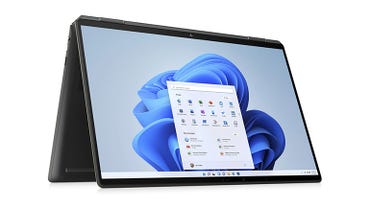HP Spectre x360 16 (2021) review: A high-quality 16-inch convertible with a superb OLED screen | ZDNet
HP’s16-inch convertible Spectre x360 16 runs on 11th-generation Intel Core processors, with integrated or discrete Nvidia graphics.
Image: HP Inc.
HP’s Spectre laptops have a distinctive design and come in four different sizes, with 13-, 14-, 15- and 16-inch screens. I was sent a convertible 16-inch Spectre x360 to review, with a Core i7 processor, a discrete Nvidia GeForce RTX 3050 Laptop GPU and an OLED touch screen. This model costs £1,999.99 (inc. VAT) in the UK. In the US, prices for the Spectre x360 16 start at $1,549.99 for a Core i7 model with integrated graphics.
HP gives the rear corners an angled design, using this feature to house a couple of ports — USB-C on the right, 3.5mm headset jack on the left. This doesn’t make for the neatest cable arrangement, but it certainly looks distinctive.
The build is solid, with recycled CNC aluminium providing a tough chassis. HP bundles a sleeve, which should protect the chassis from minor dings and scratches.
Inevitably, given its 16-inch screen, this is a large and relatively heavy laptop. It measures 24.53cm wide by 35.8cm deep by 1.99cm thick, and weighs 2.01kg. The power brick is chunky too.
Like
- Excellent 16-inch OLED screen
- Distinctive design
- Solid build
- Two Thunderbolt 4 ports always available
Don’t Like
- Only 512GB of SSD storage
- Unwieldy in handheld tablet mode
- Moderate battery life
The ‘x360’ in the name signifies that the laptop’s screen rotates all the way round to face outwards for use in tablet mode. However, working in tablet mode isn’t especially comfortable on a 16-inch device. It’s heavy, and I found it impossible to hold one-handed, and a bit of a beast to prop up on my lap or the arm of a chair. However, sat on a table in tent mode or with the screen facing away from a downward-facing keyboard, it worked very well for content consumption. It’s the usual trade-off between screen size and usability.
Screen and speakers are both good, which will benefit both productive and leisure use cases. The Bang and Olufsen speakers deliver plenty of volume with no distortion, pushing sound outwards through grilles on the upward angled front base of the chassis. This gives maximum access to audio in both laptop and tablet modes. During video calls, an AI-enabled noise reduction system also kicks in.
The screen is better than good – it’s superb. My review unit had a UHD+ (3,840 x 2,400, 283ppi) OLED touch screen. Maxing out at 400 nits, it was sharp and bright — even when running on battery power. Although I left the screen on default settings for my battery rundown test (see below), I might lower it to conserve battery life in day-to-day use.
The screen bezels could be narrower, with both top and bottom bezels a little deeper than those along the short edges, but the bottom bezel is gratifyingly small, catering for a 16:10 aspect ratio that makes for more document viewability. For the record, the screen-to-body ratio is 84.6%.
Above the screen is the webcam which is a key feature of this laptop. The 5MP camera’s shutter is activated by a hotkey rather than being a physical slider. This feels a little like overkill — a potential point of failure less likely with a physical shutter. I’d hate it to get stuck in the ‘camera covered’ position.
A range of camera features are controlled via the HP Command Centre app. These include Auto Frame, which tries to ensure that you remain in view as you move around. Obviously this can’t cater for every eventuality, but it’s a help for those who shuffle about a bit during a video call, or get up to access a document from a shelf, for example. I found that it tracked me very well. Meanwhile, Light Correction does a good job of reducing shadows on the face and darkening the background during calls.
HP Command Centre also offers Beauty Mode — the kind of feature more often seen on mobile phones. Basically it smooths out wrinkles.
The camera can also be configured for other duties in the HP Command centre, including locking and unlocking the laptop as you walk away and return, and giving a warning if you edge too close to the screen (on the basis that being too close is not good for your eyes). It can also be set to automatically cause the screen to dim if you aren’t looking directly at it, a feature designed to conserve battery life. This worked well. However, Shoulder Surfing, which is designed to alert you if someone is looking over your shoulder, was a little too keen, alerting me to my own presence.
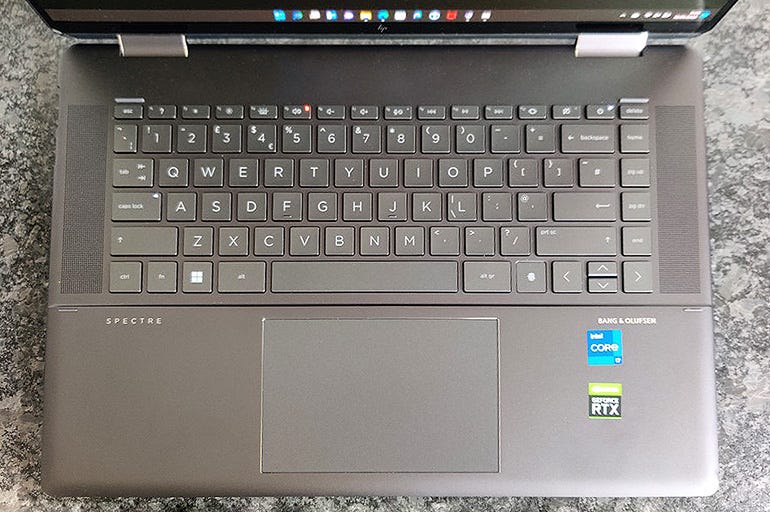
The keyboard has a responsive action, but there’s no separate number pad.
Image: Sandra Vogel / ZDNet
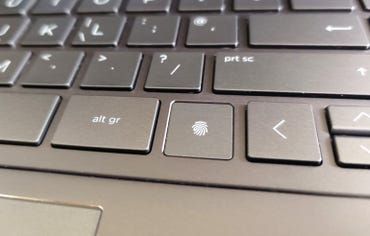
The fingerprint reader occupies a separate key space.
Image: Sandra Vogel / ZDNet
The full-size keyboard is a comfortable typing platform, with a springy and responsive action. The Enter key is only single height, but it’s wide, and the arrow keys are large. There’s a fingerprint sensor embedded in the bottom row of keys, which is something of a waste of space as it could easily have been embedded in the on/off key on the top row. Unlike on some 16-inch laptops, there’s no separate number pad here. The touchpad is large and very responsive.
My review unit was the HP Spectre x360 16-f0053na model, which is listed at £1,999.99 (inc. VAT) on HP’s UK website. Powered by an Intel Core i7-11390H processor with a discrete 4GB Nvidia GeForce RTX 3050 Laptop GPU and 16GB of RAM, it handled a range of productivity and media consumption tasks with no trouble at all. The 512GB SSD is a weak link, though: it seems too small considering this laptop’s premium price.
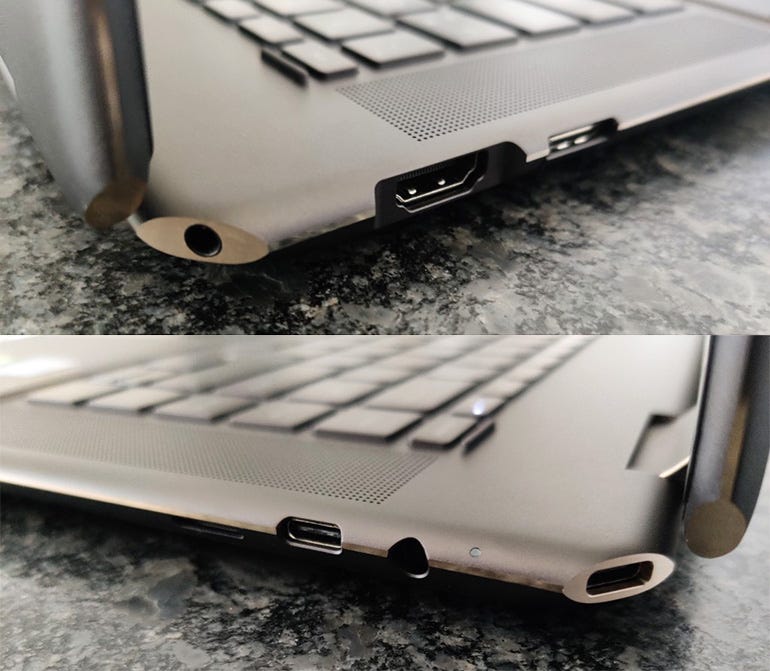
Left side (top): 3.5mm audio jack, HDMI, USB-A. Right side (above): MicroSD card reader, Thunderbolt 4/USB-C, power-in, Thunderbolt 4/USB-C.
Images: Sandra Vogel / ZDNet
It’s good to see a MicroSD card reader here, on the right-hand side. There are two Thunderbolt 4 USB-C ports, a single USB-A port, a full-size HDMI connector and a 3.5mm headset jack. The USB-A is, unusually, partly obscured by a hinged cover. With the battery charged via a round-pin connector, both USB-C ports are always available.
HP claims up to 9 hours and 15 minutes of ‘mixed usage’ for the 83Wh battery. To test this, I fully charged the battery and then worked for three hours using web apps, streaming video and occasionally audio. During this time, the battery fell from full to 52%, suggesting that a short (~6-hour) working day might be achievable on battery power, but a full 8-hour day would require access to mains power at some point.
Charging was a positive experience. On one occasion with the battery at 30% it rose to 53% after 15 minutes, to 65% after 30 minutes and to 77% after 45 minutes.
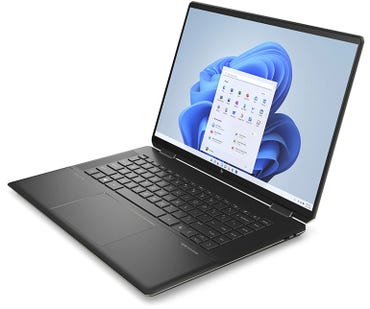
Image: HP Inc.
Conclusions
The HP Spectre x360 16 model reviewed here has a powerful processor, discrete graphics and enough battery power to keep it going for most, if not all, of the day. The 16-inch OLED screen is stunning, and audio quality is good. However, considering the price, the SSD should be double its 512GB, and the laptop’s size and weight make it unwieldy to use in handheld tablet mode.
RECENT AND RELATED CONTENT
HP revamps consumer PC lineup with 16-inch Spectre x360, 34-inch Envy all-in-one PC
HP Spectre x360 14 review: A compact 2-in-1 with a superb 3:2 OLED screen
HP Spectre x360 15 (2020) review: A premium 2-in-1 convertible with a superb 4k OLED display
Best laptops 2021: The top 5 laptops for all users
Best 2-in-1 laptop 2022: Top hybrid notebooks
Read more reviews
For all the latest Technology News Click Here
For the latest news and updates, follow us on Google News.

